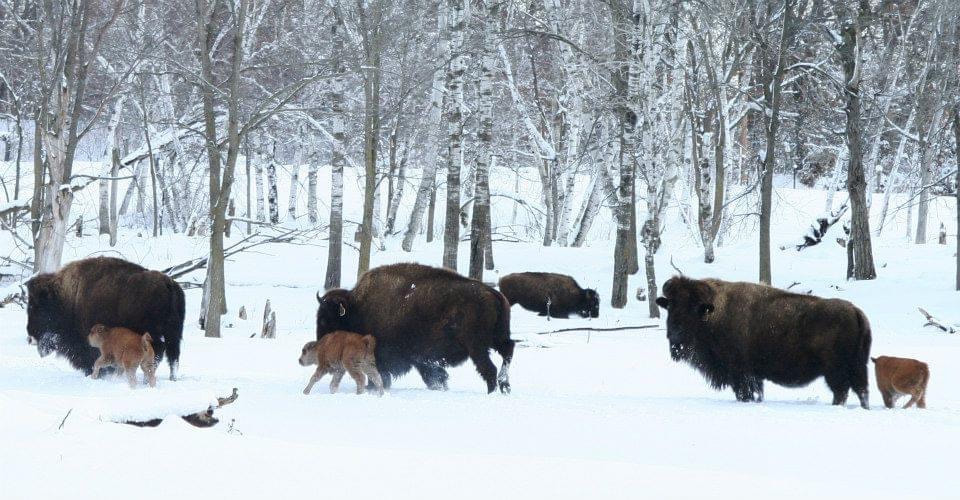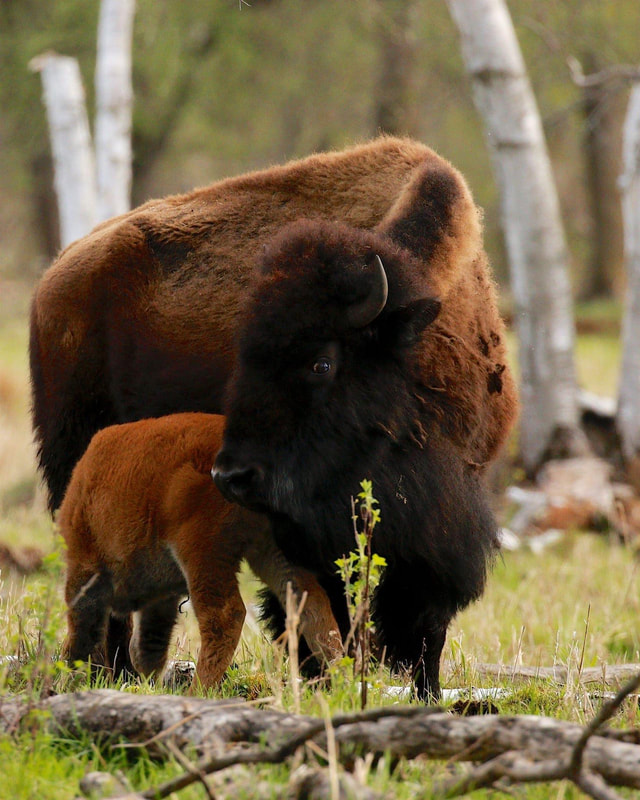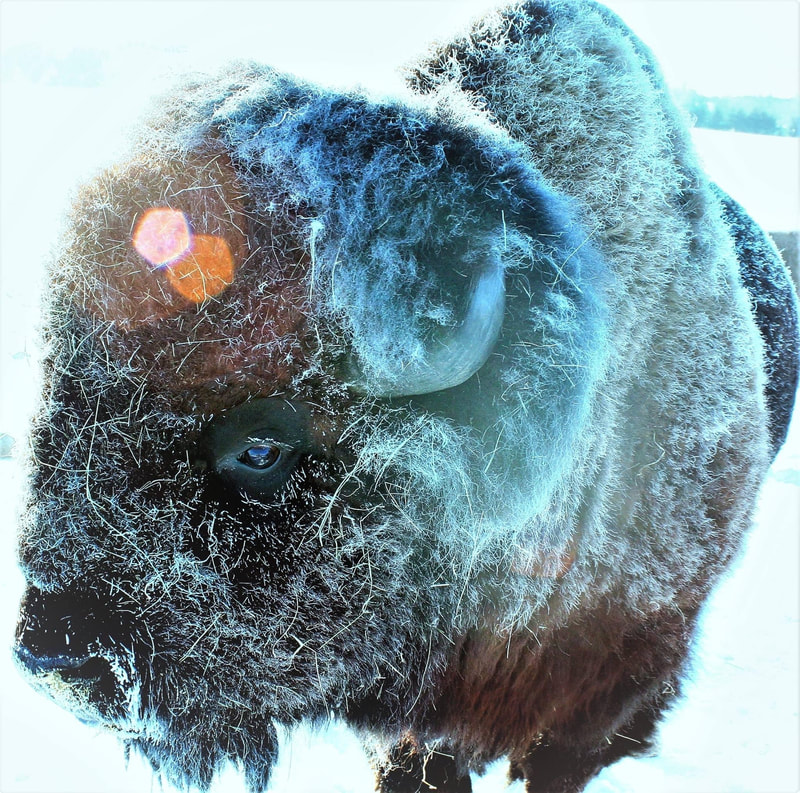|
This letter is about bison.
In the US, we use the names bison and buffalo for the same animal. The name “buffalo” technically belongs to Asian animals such as the Water Buffalo. Bison are wild animals but on farms like ours, they are also livestock. Bison have not had the long history of domestication that other livestock have. Because of that, the care and handling of bison is significantly different from other livestock. We keep a complete bison herd. That means a mature bull, a number of cows and their offspring. Our herd includes calves, yearlings and two year olds, both male and female Depending on the time of year, the herd numbers between 20 and 30 animals. The number is highest in summer after the calves are born. Lowest after the fall harvest. Bison are herd animals. They have a high social need. Bison alone or in small numbers will do poorly. Bison have a very strong herd sense and a strict hierarchy within that herd. These two factors tend to hold the herd tightly together but with space between individuals depending on status. It is extremely difficult to separate an animal from the herd. Bison becomes highly agitated if separated. Bison can become so excited when handled or when penned that occasionally a healthy animal will simply drop dead. This same factor causes buffalo stampedes. Stampedes can start easily and instantly anytime a bison herd begins to move. I see it often when moving the animals to fresh pasture. This is how a stampede occurs. I open a gate and call the animals. A few cows or the herd bull, (Bill) start moving toward the opening. Bison like to move. Those closest to the open gate may break into a lope. Other bison see the movement and fear being left behind. Those animals run toward the departing animals. Then, all the remaining bison notice the movement. In an instant, every animal is running toward those bison that headed to the open gate. The leading bison hear the herd approaching at a run. They increase their speed to a run, fearing they will be trampled from behind. Now the entire herd is running madly. Each bison getting as close as possible to the animals ahead of it. The bison in the middle and the rear of the herd are in full panic. They are running blindly with their heads down. They do not know where they are going. They just fear being left behind. The bison in front are running as fast as they can. The front bison cannot see what is directly behind because the herd is in their blind spot. They correctly fear being trampled. Those two fears, the fear of being left behind and the fear of being run down are the essential elements of a stampede. Once begun, a stampede continues until the lead bison turn in an arc. From the arcing position they can see behind and manage their fear. As the arc continues the main body of animals tends to fan out. The group loosens and slows. They fan out because they cannot actually see the lead animals and tend to keep moving straight ahead. The herd continues to loosen and slow until each animal feels that it can safely stop running. Of course, there is one other way to end a stampede. Native Americans used stampedes to kill bison by running them over a cliff. Indians would start a stampede and then have hunters located along the route to prevent the herd from turning away from a cliff. An effective method but one that annihilated the entire herd. Some years ago, I built our herd up to 70 bison. That was too many. A herd that big did not fit through my pasture gateways. When they stampeded, they broke down the gate posts. I got tired of rebuilding fences. Bigger herds require bigger farms. Thirty bison at once is enough. Bison have a unique shape. Bison have a massive head covered with long, thick hair. They use their heads to plow snow from winter grasses. This unusual adaptation allows them to survive winters in far northern plains. The large head also defines their body shape. The “hump” on the bison shoulders is made of long extensions of spinal bones and enormous straps of cartilage. The hump is necessary to move and control the bison’s extra large head. Adult bison bulls weigh over 2000 pounds. The very biggest reach 2500 pounds. Cows however, are much smaller, averaging 1000 pounds. This “dimorphism,” difference in size, is also unique to bison. Most other farm animals such as cattle, horses and pig, males and females are undistinguishable by size. Bison live to over 30 years of age. That is roughly twice as long as cattle Bison are serious about self defense. Bison use their heads and horns as weapons. Bulls tend to use their enormous heads as battering rams. Cows on the other hand tend to use their horns with a hooking motion. Most of the cows in our herd sharpen their horns. They bring the tips of the horns to a knife’s edge by rubbing on trees and rocks. Bison with young calves are particularly aroused by canines, including dogs. Bison are not afraid of horses. Some cows will aggressively defend against horses. We never put horses and bison in the same paddock. The risk of injury to the horse is too high. Bison have a strict herd hierarchy. They enforce their hierarchy instantly and violently. A lower status animal must keep its distance from a higher status animal. That distance is 5 to 20 feet depending on the situation. The only exception is during a stampede where the animals bunch tightly together. Cows in general have high status. Cows rank themselves from highest to lowest within their group. Calves have the same status as their mother but only when they are together. A cows’ yearling and two year old offspring are also protected but only when near their mother. Young animals not born in the herd have no status. They must keep their distance from virtually every herd member. This “outsider’ status in combination with their strong social need puts them under intense stress. A young bull can never gain status unless he defeats the herd bull in battle. That is not likely. I harvest young bulls before they get large enough to challenge Bill. Fighting bulls will destroy any fence in their path. A young female can gradually build status by producing calves. Young cows rise in stature over years of production. The next time you visit our bison herd observe this hierarchy in motion. Each time a high status animal takes a few steps, there is a ripple effect through the herd as every other animal moves to reset the spacing. In general, the herd will look calm as they shift positions but occasionally you will see a low status individual make a hasty move to escape the horns of a superior. Bison are dead serious about enforcing their rules. Some years ago at an auction, I purchased several cows from one farm and several large heifers from a different farm. The animals were about the same size. The sale barn workers made the mistake of putting one of the heifers in with the cows. The cows killed the heifer. The poor creature was not able to get as far from the cows as bison rules required. I seldom bring outside animals into our herd. It is too hard on them. Bison also have a fierce aversion to capture or enclosure. There is no low stress way to capture or haul bison. Most bison producers have corrals, sorting pens and squeeze chutes. Bison frequently injure themselves in these facilities. Nevertheless, such facilities are necessary to vaccinate, tag, weigh, sort and load bison. Other than pasture fences, we have no facilities for bison. It is good that others do or there would be no way to stock bison farms. Nor would there be a way to get bison from farms to grocery shelves. I pasture harvest our bison. That means I kill them in their pasture in a way that causes no stress. I am not critical of other bison farming methods. In fact, I am taking advantage of their efforts and expenditures. It is a luxury for me that I can farm without the need to sort or load our bison. I move the bison herd from pasture to pasture by leading them. I use the same methods as for cattle with one exception. I walk ahead of the cattle. I cannot do that with the bison. Once they see the open gate, they would run over me. Normally I lead the bison from a tractor seat. Sometimes I can do it from behind a gate. When harvesting cattle I walk among them, when harvesting bison I do so from a tractor. The herd bull and a couple of the cows have rammed the tractor in the past. The tractor weighs almost five tons and is made of hard stuff. They learn to vent their anger in other ways. I will explain the details of harvesting in a separate letter at the end of this sequence. Bison eat the same diet as cattle. Some textbooks teach that bison eat more browse (twigs, buds etc.) than cattle. I do not believe that is true. Animals eat what they have learned to eat. If a herd has a history of living in mixed terrain with many kinds of plants, they will over time learn the proper season and use for every plant. In a natural environment, a herd will develop the knowledge of when to eat every grass, forb, herb and brushy plant that is available. The herd will learn how to self medicate on the many herbs that grow in their range. A group at the University of Utah has done some terrific work on this topic. I never separate the members of our bison herd. That means the bull, who we call Bill is always with them. That further means that the time of calving is up to Bill and the cows. Last year most of the cows calved in April. Some years most calve in May; occasionally we will get a calf as late as October. I see no point in interfering in the sex lives of buffalo. The cows are protective of their calves, as you would expect. In the case of calving problems, there is probably nothing that can be done. I once tried to save a weak calf by taking it from its mother. My intention was to warm it, feed it and return it. The calf could not stand. I used a tractor to push the cow momentarily from the calf. I then jumped down and carried the calf onto the tractor. The cow climbed onto the tractor seat with me. I returned the doomed calf to its mother. Good cattle fencing will hold well managed bison. When bison are upset or crowded, they require extremely good fencing. If well cared for and calm, their fencing requirements are not much different from cattle. I know good bison farmers who have five strand barbwire fences and have never had their bison escape. Bison have a healthy respect for electric fence and we use it for all our pastures. Bison ranchers I learn from in Dakota use a single strand of electric fence to divide their bison pastures. I generally use two wires minimum. In my smaller Minnesota pasture, a small animal will sneak under or a large animal will jump over a single wire. Bison are great jumpers. It is crucial that the bison are well fed, watered, trained to their fences, socially stable and calm. The two wire fences I mentioned above are interior fences. Although our bison have never broken out, there is always more than one fence line between them and the road. There are major differences between having a herd of cattle get out versus a herd of bison. If your cattle get out the neighbors call and you just bring the cattle home. If your bison get out you might appear on the evening news. Best regards. Tom
0 Comments
Leave a Reply. |
Categories
All
Archives |



 RSS Feed
RSS Feed
